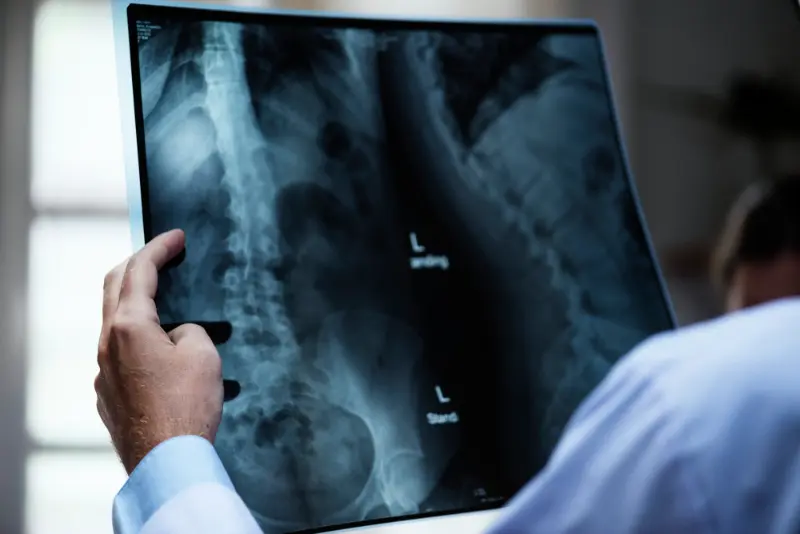Abdominal X-rays
Doctors use X-rays for diagnosing any issue or disease in the skeletal system. With the help of undetectable electromagnetic energy beams, it produces images of organs, soft tissues, and the skeleton.
In this blog, we will look at how X-rays may use radiation to produce internal organ/tissue images for diagnostic reasons. For any issue detection in the abdominal area, physicians sometimes advise doing a stomach X-ray. The X-ray cost varies depending on the requirements. With the advancement of technology, online X-ray tools have been invented to ensure that X-rays are done without any hassle. However, an online X-ray should be done only on the doctor’s advice and should be avoided in case of any side effects or reliability issues.
The Role of a Plain Abdominal X-ray
Abdominal X-rays are easy and simple to work with. Before an abdominal surgery, it is done to check the body’s ingestion, abdominal distention, irregular bowel sounds, or peritoneal signs. A Belly X-ray is the most common test that is consistently advised by doctors in the emergency departments of hospitals. Even though it is very convenient, it adds expense to healthcare and should only be asked by medical staff if required. The radiation exposure of an X-ray from the abdomen to the chest is very negligible. However, it is not minute when the cancer risk occurrence ranges from 10 to 100 mSv.
How to prepare for an abdominal X-ray
-
Guidelines about having anything to eat before an X-ray may vary from facility to facility.
-
You can follow your regular medical routine and do not need to worry about discontinuing it before the procedure.
-
Notify your doctor in case you are pregnant or terminally ill with cancer.
-
Do not wear any metal jewelry such as piercing, earrings, necklaces or clips, etc.
-
Wear loose and comfortable clothing.
-
It will not take more than 30 minutes, and soon you will be done with the X-ray.
Factors Affecting an Abdominal X-ray
An Abdominal X-ray plays no role in diagnosing the examination of constipation. It is just a screen test for diagnosing any bones, tissues, or organ problems, so it plays a limited role in abdominal pain. The online X-ray shows organs’ size, shape, and position, so it is vital to do the right pose to get the proper coverage.
Following are some common types of positions done for a belly X-ray.
1. X-ray position
Supine:
With this position, a doctor or physician can check the abdominal wall musculature and soft tissues. For this, the patient lies on the table, and an X-ray is taken.
Upright:
With this position, a doctor can see blockage or large gas-producing abscesses. For this, the patient only needs to stand and the technician can do their work. However, this abdomen X-ray position is not ideal for finding a small pneumoperitoneum.
Lateral Decubitus:
Upright might not be ideal, but Lateral Decubitus is the ideal abdominal X-ray scan for identifying small pneumoperitoneum. For this, the patient lies in a sideways position to make the procedure done.
2. Exposure
To maximize the abdominal view on an X-ray; a low KV technique is always used. However, the X-ray image quality is reduced dramatically if low mAs are used. In addition, excess scatter radiation will diminish the quality of a belly X-ray as well. By incorporating the anti-scatter grid and raising mAs, doctors can produce a high-quality X-ray scan with more precise results.
3. Anatomy cropping
It is not easy to cover everything in a single frame when doing an X-ray for a human being. Thus, it is essential to perform from many angles to get full abdominal coverage from the diaphragm to the pelvic region.
Hence, as the positioning of the X-ray varies, so does its pricing.
X-ray cost variation
The abdomen is a vast subject, and its X-ray types vary along with their costs. Therefore, while searching for labs and hospitals it is advised to search the X-ray name with its cost.
For example, if you are looking for full Abdominal coverage, it might cost you around $110 - $2,775. However, if you want special coverage like over the small intestine, it would cost $190 - $4,400, depending on the requirements.
Conclusion
A plain abdominal X-ray is always safe and carries the lowest risks. It is constantly monitored and regulated to make sure everything is done smoothly without any mistakes. It helps detect any abdominal masses, abnormal fluids, gallstones, stomach and intestines, any injuries, blockages, and even kidney stones as well.
It is so efficient and common these days that it has become a basic necessity for diagnostic procedures in the medical field.












